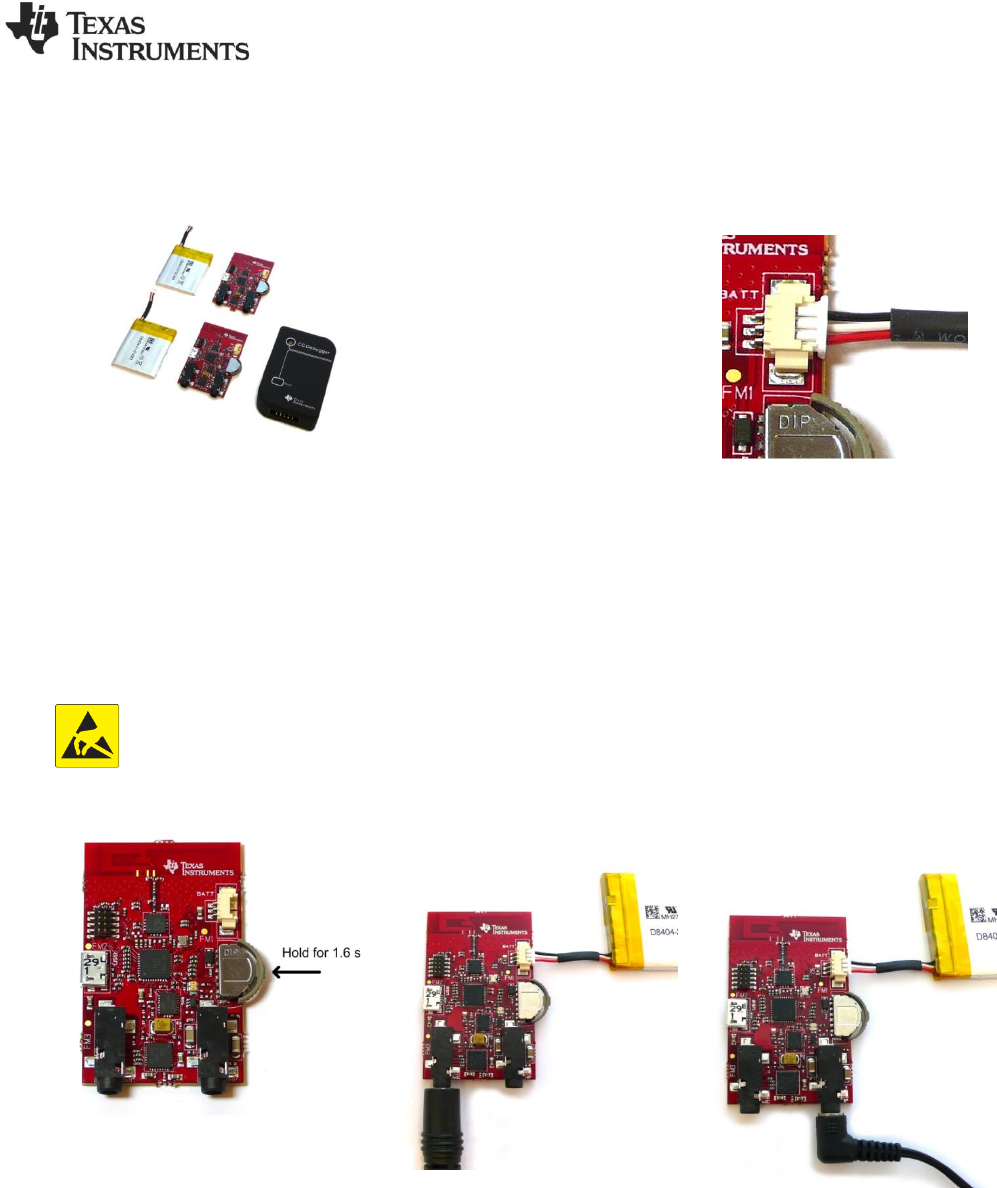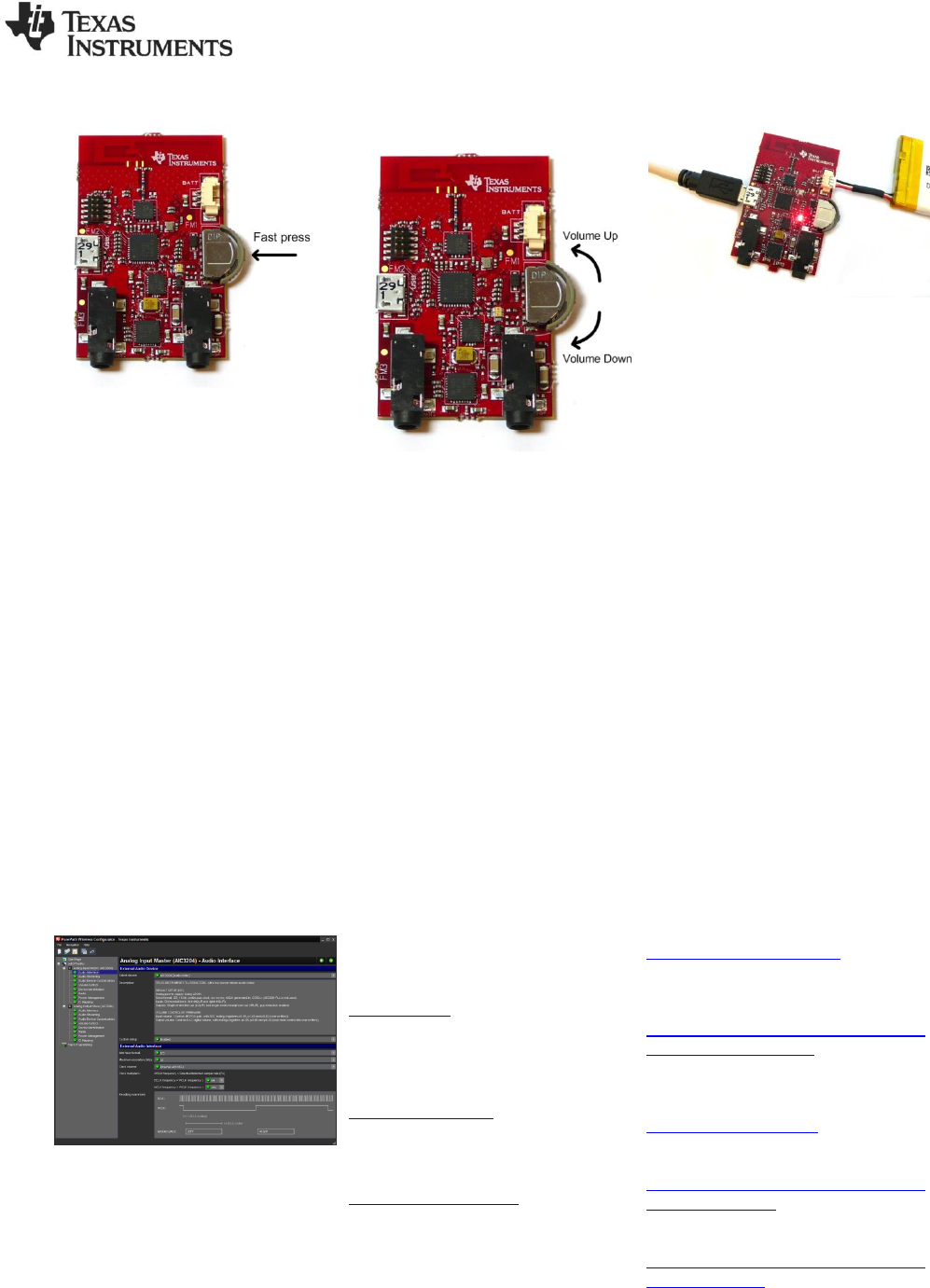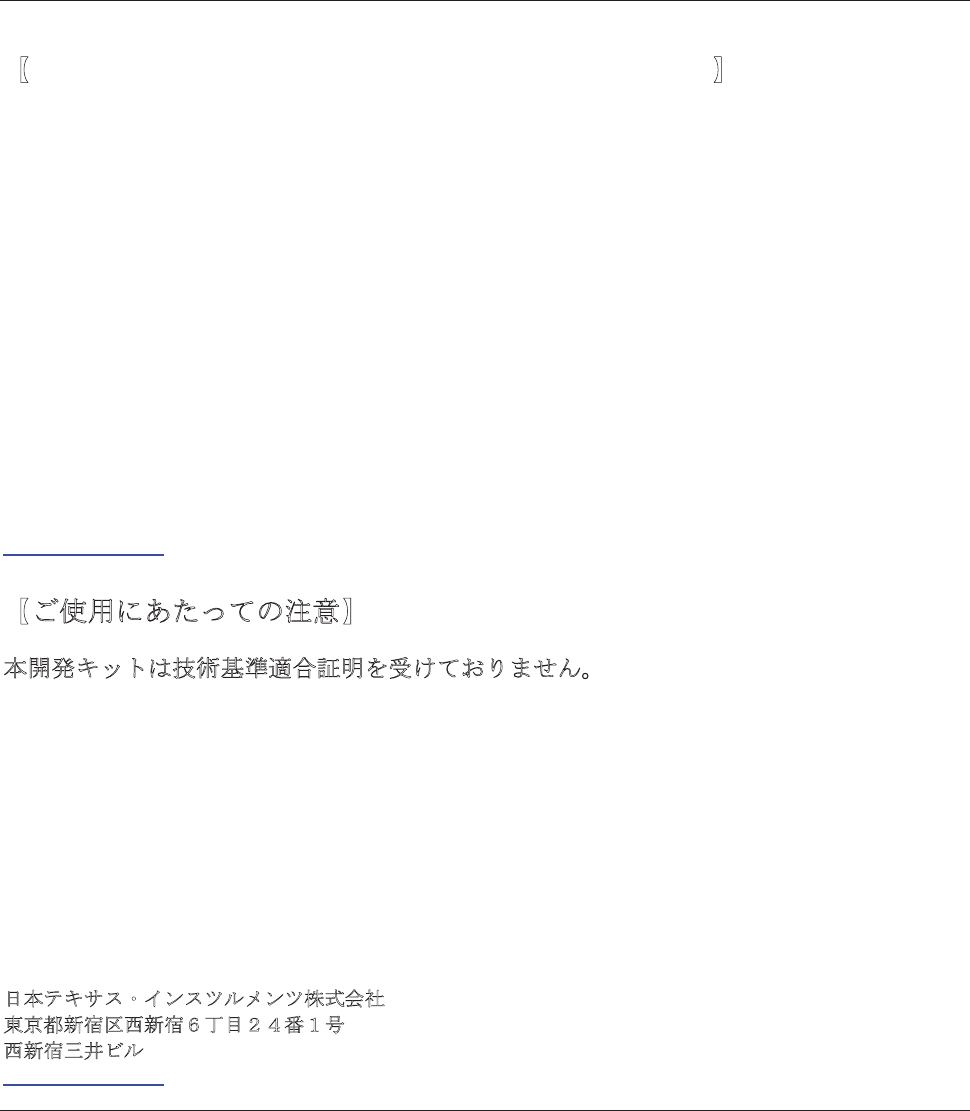Texas Instruments 85XXHEADSET The CC85xxHeadset is a reference design for wireless audio headsets for development only and cannot be used in an end product. User Manual Development Kit
Texas Instruments Inc. The CC85xxHeadset is a reference design for wireless audio headsets for development only and cannot be used in an end product. Development Kit
Users Manual

SWRU282A
June 2012
CC85XXDK-HEADSET Quick Start Guide
1. Kit Contents
The following items are included in the
CC85XXDK-HEADSET:
2 x CC85XX Headset boards
2 x Battery
1 x CC Debugger
1 x USB micro cable
1 x 3.5mm jack to 3.5mm jack cable
Documentation
If anything is missing in the CC85XXDK-
HEADSET please contact your local TI
sales representative.
Caution! The kit contains ESD
sensitive components. Handle
with care to prevent permanent
damage.
2. Purpose of this Quick Start
Guide
This quick start guide will provide step-by-
step instructions showing how to set up an
audio link between two wireless units
provided in the development kit.
The CC8531 on each of the boards are
pre-programmed with firmware to stream
audio from the Master microphone input to
the Slave headphone output. Please
follow step 3 to 9. Information on how to
upgrade with latest firmware, see step 10.
For more details on CC85XX, see the
product folder of the CC8520 [1].
Performance and functionality of the
CC8531 are strongly dependant on the
firmware. Thus, for performance testing
etc make sure the firmware used is the
latest released firmware from the TI web
site, see step 10.
3. Plug the batteries to each of
the Headset boards
There’s only one way to connect the
battery plug to the socket on the board.
With the pre-programmed firmware the
CC8531 enters the OFF power mode
when the battery is connected. The
batteries should have enough charge out-
of-the-box to establish a link and stream
audio. To charge the battery, see section
9. With full battery the link should run for
typically 15 hours, the Master being the
bottleneck. The Slave plays audio for 22
hours typically.
Warning! Always use the battery supplied
with the kits with the CC85xx Headset
boards.
4. Power up both boards
In the pre-programmed firmware the
toggling between power modes OFF and
ON is mapped to pressing the rocker
switch IN for 1.6 seconds. The two boards
are unpaired out-of-the-box, so in the ON
power mode the topmost LED should flash
once every second indicating network
state ALONE . In the OFF power mode
the LED is turned off. Make sure both
boards are flashing.
Caution! To minimize risk of injury, avoid
touching components during operation if
symbolized as hot.
Do not leave EVM powered when
unattended.
5. Connect an audio source to
the Master
Connect an audio source (CD-player,
MP3-player or similar) to the line in
connector on the Master Headset board
(labeled Master on the back side) via the
3.5mm jack cable.
The Master is pre-programmed with
firmware to set up the onboard
TLV320AIC3204 codec [2] to power down
the DAC and use the line in connector as
source to the ADC input.
6. Connect a headphone to the
Slave
Connect a headphone to the 3.5mm
headphone output on the board labeled
Slave on the back side.
The Slave is pre-programmed with
firmware to set up the onboard
TLV320AIC3204 codec [2] to power down
the ADC and have the headphone
connector as destination of the DAC
output.

SWRU282A
June 2012
7. Pairing
In the pre-programmed firmware the
pairing button is mapped to pressing the
rocker switch IN (not hold, which is power
toggling as described in 4).
Press the pairing button on either board
and observe that the LED blinking pattern
changes. It will now flash two times per
second which indicates that the device is
trying to pair with another device.
If the pairing button on the other board is
pressed within 10 seconds the devices will
pair. The Master status LED will be
constantly lit, and the Slave status LED
will flash once every 2.5 seconds. Audio is
now being streamed to the Slave.
When successfully paired the Slave will
save the Master’s device ID in non-volatile
memory and automatically try to pair with
this Master whenever in the ALONE state.
Thus pressing the pairing buttons again
will no longer be necessary (unless the
Slave is re-programmed or paired with
another Master).
8. Volume control
The pre-programmed Slave firmware is
configured to have so-called “local volume
control” meaning that the Slave controls
its own volume locally. The volume
buttons are mapped to clicking/holding the
rocker switch UP and DOWN.
9. Charging
To charge the battery, simply connect the
USB micro cable while the battery is also
connected. The charge voltage should be
5V (plugging the USB cable in your
computer will work perfectly). The bottom
LED will be lit indicating charging. When
the battery is fully charged the LED will go
dark.
The Headset board can be powered from
USB alone (remove the battery and
connect USB cable). Then the LED will be
lit the whole time.
Audio can be streamed while charging.
For information about the single chip
charger and DC/DC converter, see [4].
10. PurePath Wireless
Configurator
The next step is to download the PurePath
Wireless Configurator (PPWC) [3]. PPWC
makes it possible to explore all the
configuration options of the CC85XX
family. After creating device configurations
for Master and Slave network roles,
PPWC can program the CC85XX devices
directly through the CCDebugger
(included in the kit).
A. More information
On Texas Instruments’ Low-Power RF
web site you will find all our latest
products, application and design
notes, FAQ section, news and events
updates, and much more. Just go to
www.ti.com/lprf
The Low Power RF Online Community
has forums, blogs and videos. Use the
forums to find information, discuss and get
help with your design. Join us at
www.ti.com/lprf-forum
The TI LPRF eNewsletter keeps you up to
date on e.g. new products, application
notes, software and events. Sign up at
www.ti.com/lprfnewsletter
We hope you will enjoy working with the
CC85XX and associated Low-Power RF
products from Texas Instruments.
B. References
[1] CC8520 product web page
http://www.ti.com/CC8520
[2] TLV320AIC3204 product web
page
http://focus.ti.com/docs/prod/folders/p
rint/tlv320aic3204.html
[3] PPW Configurator product web
page
http://www.ti.com/ppwc
[4] BQ25015 product web page
http://focus.ti.com/docs/prod/folders/p
rint/bq25015.html
[5] CC2590 product web page
http://focus.ti.com/docs/prod/folders/p
rint/cc2590.html

1/2
Please read and observe the following warnings and precautions to ensure correct
and safe use of the Li-ion batteries included in this development kit.
Danger!
Failure to observe the following precautions may result in battery leakage, overheating,
explosion and/ or fire.
Do not immerse the battery in water or allow it to get wet.
Do not use or store the battery near sources of heat such as a fire or heater.
Do not use any chargers other than those included in this kit.
Do not reverse the positive (+) and negative (-) terminals.
Do not connect the battery directly to wall outlets or car cigarette-lighter sockets.
Do not put the battery into a fire or apply direct heat to it.
Do not short-circuit the battery by connecting wires or other metal objects to the positive
(+) and negative (-) terminals.
Do not carry or put the battery together with necklaces, hairpins or other metal objects.
Do not strike, throw or subject the battery to sever physical shock.
Do not pierce the battery casing with a nail or other sharp object, break it open with a
hammer, or step on it.
Do not directly solder the battery terminals.
Do not attempt to disassemble or modify the battery in any way.
Do not recharge the battery near a fire or in extremely hot conditions.
Warning!
Failure to observe the following precautions may result in battery leakage, overheating,
explosion and/ or fire.
Do not place the battery in a microwave oven or pressurized container.
Do not use the battery in combination with primary batteries (such as dry-cell batteries)
or batteries of different capacity, type or brand.
Do not use the battery if it gives off an odor, generates heat, becomes discolored or
deformed, or appears abnormal in any way. If the battery is in use or being recharged,
remove it from the device or charger immediately and discontinue use.
Keep the batteries out of the reach of children. If a child somehow swallows a battery,
seek medical attention immediately.
If the battery leaks or emits an odor, immediately remove it from the proximity of any
exposed flame. The leaking electrolyte can ignite and cause a fire or explosion.
If the battery leaks and electrolyte gets in your eyes, do not rub them. Instead, rinse
them with clean running water and immediately seek medical attention. If left as is,
electrolyte can cause eye injury.

2/2
Caution!
Do not use or store the battery where is exposed to extremely hot, such as under window of
a car in direct sunlight in a hot day. Otherwise, the battery may be overheated. This can
also reduce battery performance and/or shorten service life.
Use the battery only under the following environmental conditions. Failure to do so can
result in reduced performance or a shorten service life. Recharging the battery outside of
these temperatures can cause the battery to overheat, explode or catch fire.
Operating environment:
When charging the battery: 0ºC~45ºC
When discharging the battery: -10 ºC~60 ºC
When stored up to 1 year: -20 ºC~30 ºC
When stored up to 1 month: Max. 55 ºC
In cases where children use the battery, instruct them on the contents of the user’s guide
and keep an eye on them to ensure that the battery is being used correctly.
If the battery leaks and electrolyte gets your skin or clothing, immediately rinse the affected
area with clean running water. If left as is, skin inflammation can occur.
For directions on battery installation and removal, read the instruction manual that
accompanies the equipment in which the battery will be used.
If a device is not used for an extended period, the battery should be removed and stored in
a cool, dry place. Otherwise, resting or reduced performance may occur.
If the terminals of the battery are dirty, wipe them clean with dry cloth before use.
Otherwise, solid electrical contact may not be charged with the equipment, and this can
cause power outages or charging to fail.

EVALUATION BOARD/KIT/MODULE (EVM) ADDITIONAL TERMS
Texas Instruments (TI) provides the enclosed Evaluation Board/Kit/Module (EVM) under the following
conditions:
The user assumes all responsibility and liability for proper and safe handling of the goods. Further, the user
indemnifies TI from all claims arising from the handling or use of the goods.
Should this evaluation board/kit not meet the specifications indicated in the User’s Guide, the board/ kit may
be returned within 30 days from the date of delivery for a full refund. THE FOREGOING LIMITED
WARRANTY IS THE EXCLUSIVE WARRANTY MADE BY SELLER TO BUYER AND IS IN LIEU OF ALL
OTHER WARRANTIES, EXPRESSED, IMPLIED, OR STATUTORY, INCLUDING ANY WARRANTY OF
MERCHANTABILITY OR FITNESS FOR ANY PARTICULAR PURPOSE. EXCEPT TO THE EXTENT OF
THE INDEMNITY SET FORTH ABOVE, NEITHER PARTY SHALL BE LIABLE TO THE OTHER FOR ANY
INDIRECT, SPECIAL, INCIDENTAL, OR CONSEQUENTIAL DAMAGES.
Please read the User's Guide and, specifically, the Warnings and Restrictions notice in the User's Guide
prior to handling the product. This notice contains important safety information about temperatures and
voltages. For additional information on TI's environmental and/or safety programs, please visit
www.ti.com/esh or contact TI.
No license is granted under any patent right or other intellectual property right of TI covering or relating to
any machine, process, or combination in which such TI products or services might be or are used. TI
currently deals with a variety of customers for products, and therefore our arrangement with the user is not
exclusive. TI assumes no liability for applications assistance, customer product design, software
performance, or infringement of patents or services described herein.
Mailing Address: Texas Instruments Post Office Box 655303 Dallas, Texas 75265
Copyright 2011, Texas Instruments Incorporated
REGULATORY COMPLIANCE INFORMATION
As noted in the EVM User’s Guide and/or EVM itself, this EVM and/or accompanying hardware may or may
not be subject to the Federal Communications Commission (FCC) and Industry Canada (IC) rules.
For EVMs not subject to the above rules, this evaluation board/kit/module is intended for use for
ENGINEERING DEVELOPMENT, DEMONSTRATION OR EVALUATION PURPOSES ONLY and is not
considered by TI to be a finished end product fit for general consumer use. It generates, uses, and can
radiate radio frequency energy and has not been tested for compliance with the limits of computing devices
pursuant to part 15 of FCC or ICES-003 rules, which are designed to provide reasonable protection against
radio frequency interference. Operation of the equipment may cause interference with radio communications,
in which case the user at his own expense will be required to take whatever measures may be required to
correct this interference.
General Statement for EVMs including a radio
User Power/Frequency Use Obligations: This radio is intended for development/professional use only in
legally allocated frequency and power limits. Any use of radio frequencies and/or power availability of this
EVM and its development application(s) must comply with local laws governing radio spectrum allocation and
power limits for this evaluation module. It is the user’s sole responsibility to only operate this radio in legally
acceptable frequency space and within legally mandated power limitations. Any exceptions to this is strictly
prohibited and unauthorized by Texas Instruments unless user has obtained appropriate
experimental/development licenses from local regulatory authorities, which is responsibility of user including
its acceptable authorization.

For EVMs annotated as FCC – FEDERAL COMMUNICATIONS COMMISSION Part 15 Compliant
Caution
This device complies with part 15 of the FCC Rules. Operation is subject to the following two conditions: (1)
This device may not cause harmful interference, and (2) this device must accept any interference received,
including interference that may cause undesired operation.
Changes or modifications not expressly approved by the party responsible for compliance could void the
user's authority to operate the equipment.
FCC Interference Statement for Class A EVM devices
This equipment has been tested and found to comply with the limits for a Class A digital device, pursuant to
part 15 of the FCC Rules. These limits are designed to provide reasonable protection against harmful
interference when the equipment is operated in a commercial environment. This equipment generates, uses,
and can radiate radio frequency energy and, if not installed and used in accordance with the instruction
manual, may cause harmful interference to radio communications. Operation of this equipment in a
residential area is likely to cause harmful interference in which case the user will be required to correct the
interference at his own expense.
FCC Interference Statement for Class B EVM devices
This equipment has been tested and found to comply with the limits for a Class B digital device, pursuant to
part 15 of the FCC Rules. These limits are designed to provide reasonable protection against harmful
interference in a residential installation. This equipment generates, uses and can radiate radio frequency
energy and, if not installed and used in accordance with the instructions, may cause harmful interference to
radio communications. However, there is no guarantee that interference will not occur in a particular
installation. If this equipment does cause harmful interference to radio or television reception, which can be
determined by turning the equipment off and on, the user is encouraged to try to correct the interference by
one or more of the following measures:
Reorient or relocate the receiving antenna.
Increase the separation between the equipment and receiver.
Connect the equipment into an outlet on a circuit different from that to which the receiver is
connected.
Consult the dealer or an experienced radio/TV technician for help.

For EVMs annotated as IC – INDUSTRY CANADA Compliant
This Class A or B digital apparatus complies with Canadian ICES-003.
Changes or modifications not expressly approved by the party responsible for compliance could void the
user’s authority to operate the equipment.
Concerning EVMs including radio transmitters
This device complies with Industry Canada licence-exempt RSS standard(s). Operation is subject to the
following two conditions: (1) this device may not cause interference, and (2) this device must accept any
interference, including interference that may cause undesired operation of the device.
Concerning EVMs including detachable antennas
Under Industry Canada regulations, this radio transmitter may only operate using an antenna of a type and
maximum (or lesser) gain approved for the transmitter by Industry Canada. To reduce potential radio
interference to other users, the antenna type and its gain should be so chosen that the equivalent
isotropically radiated power (e.i.r.p.) is not more than that necessary for successful communication.
This radio transmitter has been approved by Industry Canada to operate with the antenna types listed in the
user guide with the maximum permissible gain and required antenna impedance for each antenna type
indicated. Antenna types not included in this list, having a gain greater than the maximum gain indicated for
that type, are strictly prohibited for use with this device.
~
Cet appareil numérique de la classe A ou B est conforme à la norme NMB-003 du Canada.
Les changements ou les modifications pas expressément approuvés par la partie responsable de la
conformité ont pu vider l’autorité de l'utilisateur pour actionner l'équipement.
Concernant les EVMs avec appareils radio
Le présent appareil est conforme aux CNR d'Industrie Canada applicables aux appareils radio exempts de
licence. L'exploitation est autorisée aux deux conditions suivantes : (1) l'appareil ne doit pas produire de
brouillage, et (2) l'utilisateur de l'appareil doit accepter tout brouillage radioélectrique subi, même si le
brouillage est susceptible d'en compromettre le fonctionnement.
Concernant les EVMs avec antennes détachables
Conformément à la réglementation d'Industrie Canada, le présent émetteur radio peut fonctionner avec une
antenne d'un type et d'un gain maximal (ou inférieur) approuvé pour l'émetteur par Industrie Canada. Dans
le but de réduire les risques de brouillage radioélectrique à l'intention des autres utilisateurs, il faut choisir le
type d'antenne et son gain de sorte que la puissance isotrope rayonnée équivalente (p.i.r.e.) ne dépasse pas
l'intensité nécessaire à l'établissement d'une communication satisfaisante.
Le présent émetteur radio a été approuvé par Industrie Canada pour fonctionner avec les types d'antenne
énumérés dans le manuel d’usage et ayant un gain admissible maximal et l'impédance requise pour chaque
type d'antenne. Les types d'antenne non inclus dans cette liste, ou dont le gain est supérieur au gain
maximal indiqué, sont strictement interdits pour l'exploitation de l'émetteur.

ޣImportant Notice for Users of this Product in Japanޤ
This development kit is NOT certified as Confirming to Technical Regulations of
Radio Law of Japan!
If you use this product in Japan, you are required by Radio Law of Japan to follow the instructions below with
respect to this product:
(1) Use this product in a shielded room or any other test facility as defined in the notification #173
issued by Ministry of Internal Affairs and Communications on March 28, 2006, based on Sub-section 1.1 of
Article 6 of the Ministry’s Rule for Enforcement of Radio Law of Japan,
(2) Use this product only after you obtained the license of Test Radio Station as provided in Radio
Law of Japan with respect to this product, or
(3) Use of this product only after you obtained the Technical Regulations Conformity Certification as
provided in Radio Law of Japan with respect to this product.
Also, please do not transfer this product, unless you give the same notice above to the transferee.
Please note that if you could not follow the instructions above, you will be subject to penalties of Radio Law
of Japan.
Texas Instruments Japan Limited
(address) 24-1, Nishi-Shinjuku 6 chome, Shinjukku-ku, Tokyo, Japan
http://www.tij.co.jp
ޣߏ↪ߦߚߞߡߩᵈᗧޤ
ᧄ㐿⊒ࠠ࠶࠻ߪᛛⴚၮḰㆡว⸽ࠍฃߌߡ߅ࠅ߹ߖࠎޕ
ᧄຠߩߏ↪ߦ㓙ߒߡߪޔ㔚ᵄᴺㆩߩߚޔએਅߩߕࠇ߆ߩភ⟎ࠍขߞߡߚߛߊᔅⷐ߇ࠅ߹ߔߩ
ߢߏᵈᗧߊߛߐޕ
㧔㧝㧕㔚ᵄᴺᣉⴕⷙೣ╙6᧦╙1㗄╙1ภߦၮߠߊᐔᚑ18ᐕ328ᣣ✚ോ⋭๔␜╙173ภߢቯࠄࠇߚ
㔚ᵄᥧቶ╬ߩ⹜㛎⸳ߢߏ↪ߚߛߊޕ
㧔㧞㧕ታ㛎ዪߩ⸵ࠍขᓧᓟߏ↪ߚߛߊޕ
㧔㧟㧕ᛛⴚၮḰㆡว⸽ࠍขᓧᓟߏ↪ߚߛߊޕ
ߥ߅ޔᧄຠߪޔ⸥ߩޟߏ↪ߦߚߞߡߩᵈᗧޠࠍ⼑ᷰవޔ⒖ォవߦㅢ⍮ߒߥ㒢ࠅޔ⼑ᷰޔ⒖ォߢ߈
ߥ߽ߩߣߒ߹ߔޕ
⸥ࠍㆩ㗂ߌߥ႐วߪޔ㔚ᵄᴺߩ⟏ೣ߇ㆡ↪ߐࠇࠆน⢻ᕈ߇ࠆߎߣࠍߏ⇐ᗧߊߛߐޕ
ᣣᧄ࠹ࠠࠨࠬࠗࡦࠬ࠷࡞ࡔࡦ࠷ᩣᑼળ␠
᧲੩ㇺᣂኋᣂኋ㧢ৼ⋡㧞㧠⇟㧝ภ
ᣂኋਃࡆ࡞
http://www.tij.co.jp
EVALUATION BOARD/KIT/MODULE (EVM)
WARNINGS, RESTRICTIONS AND DISCLAIMERS
For Feasibility Evaluation Only, in Laboratory/Development Environments. Unless otherwise indicated,
this EVM is not a finished electrical equipment and not intended for consumer use. It is intended solely for
use for preliminary feasibility evaluation in laboratory/development environments by technically qualified
electronics experts who are familiar with the dangers and application risks associated with handling electrical
mechanical components, systems and subsystems. It should not be used as all or part of a finished end
product.
Your Sole Responsibility and Risk. You acknowledge, represent and agree that:
1. You have unique knowledge concerning Federal, State and local regulatory requirements (including but
not limited to Food and Drug Administration regulations, if applicable) which relate to your products and
which relate to your use (and/or that of your employees, affiliates, contractors or designees) of the EVM
for evaluation, testing and other purposes.
2. You have full and exclusive responsibility to assure the safety and compliance of your products with all
such laws and other applicable regulatory requirements, and also to assure the safety of any activities to
be conducted by you and/or your employees, affiliates, contractors or designees, using the EVM.
Further, you are responsible to assure that any interfaces (electronic and/or mechanical) between the
EVM and any human body are designed with suitable isolation and means to safely limit accessible
leakage currents to minimize the risk of electrical shock hazard.
3. You will employ reasonable safeguards to ensure that your use of the EVM will not result in any property
damage, injury or death, even if the EVM should fail to perform as described or expected.
4. You will take care of proper disposal and recycling of the EVM’s electronic components and packing
materials
Certain Instructions. It is important to operate this EVM within TI’s recommended specifications and
environmental considerations per the user guidelines. Exceeding the specified EVM ratings (including but not
limited to input and output voltage, current, power, and environmental ranges) may cause property damage,
personal injury or death. If there are questions concerning these ratings please contact a TI field
representative prior to connecting interface electronics including input power and intended loads. Any loads
applied outside of the specified output range may result in unintended and/or inaccurate operation and/or
possible permanent damage to the EVM and/or interface electronics. Please consult the EVM User's Guide
prior to connecting any load to the EVM output. If there is uncertainty as to the load specification, please
contact a TI field representative. During normal operation, some circuit components may have case
temperatures greater than 60 C as long as the input and output are maintained at a normal ambient
operating temperature. These components include but are not limited to linear regulators, switching
transistors, pass transistors, and current sense resistors which can be identified using the EVM schematic
located in the EVM User's Guide. When placing measurement probes near these devices during normal
operation, please be aware that these devices may be very warm to the touch. As with all electronic
evaluation tools, only qualified personnel knowledgeable in electronic measurement and diagnostics
normally found in development environments should use these EVMs
Agreement to Defend, Indemnify and Hold Harmless. You agree to defend, indemnify and hold TI, its
licensors and their representatives harmless from and against any and all claims, damages, losses,
expenses, costs and liabilities (collectively, "Claims") arising out of or in connection with any use of the EVM
that is not in accordance with the terms of the agreement. This obligation shall apply whether Claims arise
under law of tort or contract or any other legal theory, and even if the EVM fails to perform as described or
expected.
Safety-Critical or Life-Critical Applications. If you intend to evaluate the components for possible use in
safety critical applications (such as life support) where a failure of the TI product would reasonably be
expected to cause severe personal injury or death, such as devices which are classified as FDA Class III or
similar classification, then you must specifically notify TI of such intent and enter into a separate Assurance
and Indemnity Agreement.